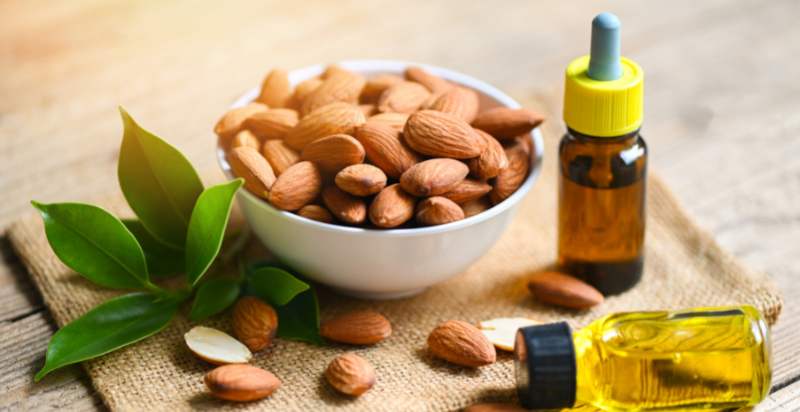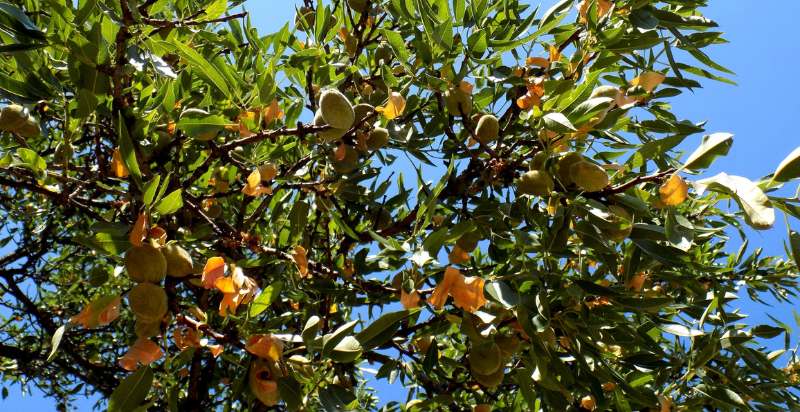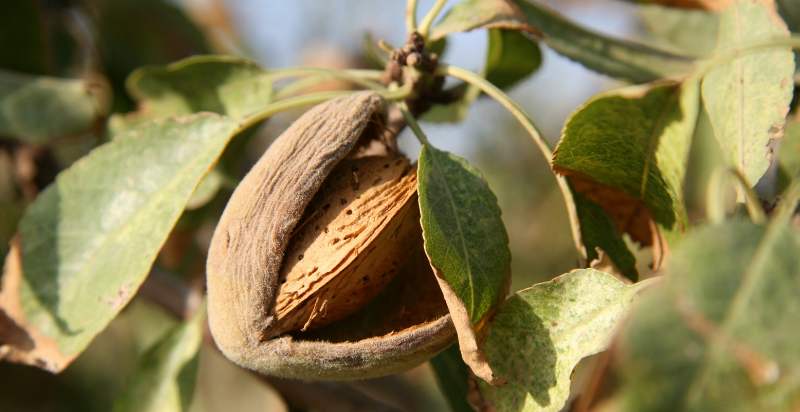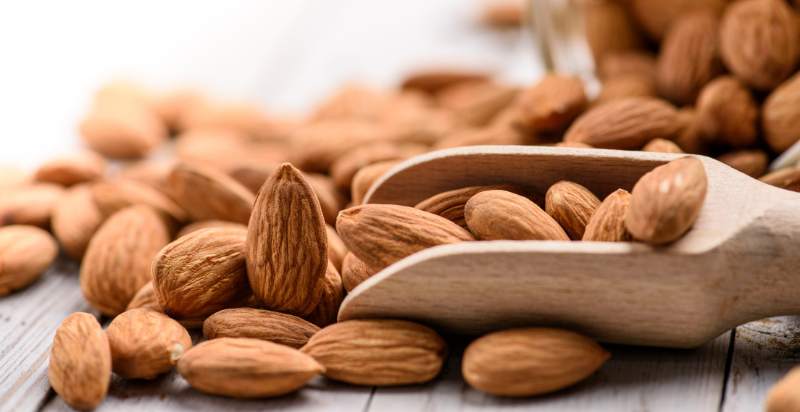Almonds are one of the most popular and versatile nuts, used in everything from baking to snacking. Known for its creamy texture and nutty flavor, almonds are an excellent source of protein, fiber, healthy fats, vitamins, and minerals. They’re also packed with antioxidants that can help protect against chronic health conditions such as heart disease and cancer. From milk to oil, almond products are increasingly making their way into the health food market. Here’s everything you need to know about almonds and how they can benefit your health.
What are Almonds?
Almonds are the edible seeds of the almond tree. They’re packed with health-promoting nutrients such as protein, fiber, healthy fats, and vitamins and minerals. Almonds come in two varieties: sweet and bitter. Sweet almonds are the most commonly consumed type, while bitter almonds have a higher concentration of certain toxins and aren’t safe to eat.
History and Origin of Almonds:
Almonds have been cultivated for thousands of years. They are indigenous to the Middle East and South Asia, likely originating in what is now Iraq and Iran around 3000 BC. The ancient Greeks so highly regarded almonds that they used them as offerings in religious ceremonies. Arabs spread almonds throughout North Africa and Spain, while traders took them to Italy, France, and Germany. By the 16th century, Franciscan missionaries grew almonds in California.
Today, almond trees are cultivated worldwide in warm climates; the United States is now one of the largest producers of almonds.
Varieties of Almonds:
Nonpareil, Mission, Butte, and Carmel are the most widely cultivated almond varieties. Nonpareil almonds are the most popular variety due to their high oil content and sweet taste. Butte is a smaller version of the Nonpareil that is less expensive and commonly used for ingredients in food products. Mission almonds have a rich flavor and are mostly used as snacks or raw almonds in recipes. Carmel is the least common but has a mellow sweetness that makes it great for baking. All these varieties have different levels of crunchiness, flavor, nutrition, and cost, making each one suitable for different uses. Almonds are also available in shelled, blanched, roasted, or flavored forms to meet various needs depending on your recipe.
No matter which variety you choose, almonds are a great choice for snacks, baking recipes, and cooking.
Health Benefits of Almonds:
Almonds are considered a superfood due to their many health benefits. They are packed with vitamins and minerals, are a good source of protein, and contain healthy fats. Almonds have been linked to improved cholesterol levels, lower blood pressure, reduced inflammation, better heart health, and other benefits.
One of the primary reasons almonds are so beneficial is because they contain high amounts of monounsaturated fat. Monounsaturated fats can help lower LDL (bad) cholesterol while raising your body’s HDL (good) cholesterol levels. This helps reduce your heart disease and stroke risk by improving your overall cholesterol profile. Additionally, almonds contain large amounts of magnesium, which has been shown to support healthy blood sugar levels and reduce your risk for type 2 diabetes.
Almonds are also a great source of antioxidants, which help protect your cells from damage caused by free radicals. These antioxidants can help protect your body from the oxidative stress associated with aging and reduce inflammation in the body.
Finally, almonds contain large amounts of dietary fiber, which can help you feel fuller longer and aid in weight control. Fiber helps regulate digestion and controls blood sugar levels, making it a beneficial food for those looking to manage their weight or maintain optimal health.
Eating almonds as part of a healthy diet can provide numerous health benefits, including improved cholesterol levels, lower blood pressure, better heart health, reduced inflammation, reduced risk of type 2 diabetes, protection from oxidative stress, and improved weight control. To reap these benefits, try adding a handful of almonds to your daily meal plan.
Nutritional Value of Almonds:
Almonds are one of the most nutritious nuts available. They are packed with vital vitamins, minerals, and antioxidants that help keep your body healthy and functioning properly. A single ounce (28 grams) of almonds contains:
- Calories: 161
- Protein: 6 grams
- Carbs: 6 grams
- Fiber: 3.5 grams
- Fat: 14 grams
- Manganese: 32% of the Daily Value (DV)
- Magnesium: 19% of the DV
- Vitamin E: 37% of the DV
- Copper: 24% of the DV
- Riboflavin (vitamin B2): 20% of the DV
- Phosphorus: 17% of the DV
- Iron: 5% of the DV
- Zinc: 5% of the DV
- Folate: 4% of the DV
In addition to these essential nutrients, almonds contain high levels of healthy omega-3 and monounsaturated fatty acids. These compounds may help reduce inflammation and decrease your risk for chronic diseases like heart disease and type 2 diabetes. Almonds are also rich in antioxidants that can help protect your cells from damage caused by oxidation.
Almonds are nutritious, providing important vitamins, minerals, and healthy fats. Eating them regularly may reduce your risk for certain chronic diseases while providing other health benefits.
Uses of Almonds:
Almonds are extremely versatile and can be used in a variety of recipes. They make a great snack on their own, packed with essential nutrients like fiber, protein, healthy fats, vitamin E, and magnesium. Almonds are also delicious when chopped and added to salads or used as a crunchy topping for oats or yogurt. Their slightly sweet flavor works equally well in savory dishes such as curries, stir-fries, casseroles, and even soups.
You can also use almond flour for baking cakes, muffins, and other treats. Furthermore, almonds can be incorporated into nut butter or almond milk – an alternative to dairy that is becoming increasingly popular among vegans. Finally, you can use almond oil for various purposes, including as a base for salad dressings and marinades.
Overall, almonds are incredibly versatile and can be used in many different ways to add flavor, texture, nutrition, and health benefits to your diet. With so many uses, it’s no wonder these little nuts are becoming an increasingly popular ingredient in sweet and savory recipes!

How to Plant Almonds?
Almonds are highly nutritious, full of healthy fats and protein, and can be used in various recipes. Planting an almond tree is easy, and the rewards can be great, as you will have access to fresh, delicious almonds for years to come. This section will walk you through planting and caring for your almond tree.
Selecting a Site
When selecting a site for your almond tree, choose an area with plenty of sunlight. Almonds prefer full sun, so try to find a place where they will get at least 8 hours of direct sunlight each day. The soil should be well-drained and have some organic material in it like compost or shredded leaves. Avoid areas with standing water as they can cause root rot. Select an area sheltered from strong winds, such as near bushes or fences.
Preparing the Soil
Before planting, test your soil’s pH to ensure it is between 6.5 and 7.5. If it’s too acidic, mix in some lime; if it’s too alkaline, add sulfur. Also, till the soil to a depth of 12 inches and remove any debris or rocks from the area.
Planting
Once you have chosen a site and prepared the soil, it’s time to plant your almond tree! Plant your tree at least 15 feet away from any other trees, as they need plenty of room to grow. Dig a hole that is twice as wide as the roots of the tree and just deep enough for them to fit into without bending or breaking. Place the tree in the hole so that the top of the roots is level with the soil, then fill in the sides and press down firmly.
Watering
Your almond tree should be watered about twice a week during its first year, but check the soil before you water it. If it feels moist at least an inch below the surface, water is not needed. In subsequent years, reduce your watering frequency to once a week or less if needed. Almonds don’t like their roots sitting in water for too long, so avoid over-watering.
Fertilizing
Almond trees should be fertilized every spring with a balanced fertilizer such as 10-10-10 or 8-8-8. Spread the fertilizer evenly around the tree’s base and water it well. Also, add an organic mulch such as shredded leaves or wood chips around the base of your tree to help retain moisture and prevent weeds.
Harvesting
Your almond tree should begin bearing fruit after about three years, but you may need to wait up to five years for a full crop. When the almonds are ripe, they will drop off easily from the tree and can be collected by hand or with a rake.

How to Care for and Grow Almonds?
Almonds are a healthy, delicious snack that can provide numerous health benefits. They are easy to grow and can be found in many grocery stores and online in raw, blanched, or roasted form. To care for your almond trees, ensure they receive enough water, sunlight, and nutrients.
- Watering: Almond trees need plenty of water to keep them growing healthy. Please make sure the soil is moist but not soggy by checking it regularly with your finger. Water deeply so the roots get adequate moisture.
- Fertilizing: Feed your almond tree with a balanced fertilizer once every two or three months during the spring and summer. Avoid overfertilization which can lead to excessive growth and reduce the quality and flavor of your almonds.
- Pruning: Prune your almond tree regularly to keep it healthy by removing dead, diseased, or weak branches. This also helps improve air circulation which can help prevent insect and disease problems.
- Harvesting: Once the trees are mature (this can take up to five years), you can start harvesting your almonds in late summer or early fall. Carefully gather the nuts from the ground after they have fallen off the tree naturally, being careful not to bruise them as this will decrease their shelf life. Use gloves when handling almonds as they contain high contaminants that may be absorbed through skin contact.
With proper care and attention, you will be able to enjoy the delicious, nutritious almonds from your own almond tree for years to come.

Preventions from Pests and Diseases of Almonds:
Almonds are susceptible to various pests and diseases, so preventive measures should be taken for their protection. Here are some common prevention strategies:
- Plant varieties bred to resist or tolerate pests and diseases.
- Select disease-resistant rootstocks when possible.
- Ensure the trees have adequate spacing between them to help promote air circulation and reduce fungal growth on leaves and nuts.
- Remove infected branches or entire trees if needed to prevent the spread of disease.
- Monitor for signs of insect damage using traps or pheromone lures, then use appropriate physical or chemical control methods if necessary.
- Provide proper nutrition with fertilizers tailored to the needs of the trees.
- Rotate crops to reduce soil buildup of pests and diseases.
- Use protective coverings (such as floating row covers) on young plants to prevent insect damage.
- Prune regularly to keep trees healthy and promote better air circulation within canopies, which helps reduce fungal growth on leaves and nuts.
- Keep weeds away from trees, as they can harbor insects or provide food for various pest species.
- Maintain proper irrigation techniques to help minimize disease development in roots and foliage, such as avoiding excessive moisture or periods of drought stress for too long.
- Monitor for signs of insect activity or damage by inspecting nuts, leaves, branches, and trunks regularly.
- If insect pests or diseases do appear, use appropriate control measures as soon as possible to minimize damage and spread of the problem.
- Sanitize tools and equipment (such as pruners) regularly to reduce the spread of diseases they may carry between trees.
- Check for signs of disease in stored nuts, as fungi or bacteria can develop during storage if not properly monitored.
Follow good hygiene procedures when handling and processing nuts, such as washing hands before and after any contact with the product to minimize contamination by pests or diseases.
These simple but important steps can help protect almonds from pest and disease problems. Adhering to these practices should help ensure a successful harvest season!
How to Harvest Almonds?
Step 1: Wait until the almond tree is ready to harvest – Almonds are typically harvested in late summer/early fall once they have ripened. Check your almonds’ color to ensure they are a deep, solid brown. If you wait past a certain point, the nuts can become overly ripe and drop off the trees.
Step 2: Prepare your container for harvesting – Collect a bucket or container that has been cleaned and sterilized beforehand. Make sure you also have a clean broom and some soft clothes.
Step 3: Start shaking – Gently shake each almond tree limb with your hands or a broom handle to dislodge the ripe almonds from their branches. Be careful not to shake too hard, as you could damage the tree and the newly harvested nuts.
Step 4: Collect the almonds – Place a clean cloth on the ground beneath your almond tree. Once you have shaken all limbs, gather up the fallen almonds with your hands or a soft broom and place them in your container.
Step 5: Shell and dry – Once you have gathered all your almonds, carefully shell each one by hand and then spread them out on clean cloths to dry in direct sunlight. This process can take several days, depending on how many almonds you are drying.
And there you have it! You now know how to harvest almonds step by step. Following these simple steps, you can enjoy freshly harvested almonds all year round! Happy harvesting! Good luck!

How to Store Homegrown Almonds?
The best way to store homegrown almonds is to keep them in a cool, dry place. It’s important to avoid keeping them in direct sunlight or near any heat source, as the warm environment can cause them to spoil quickly. Almonds should also be stored away from sources of moisture, such as steam and humidity, which can cause mold growth.
If you have space in your refrigerator or freezer, this is an ideal location for storing almonds. Store the nuts in airtight containers or resealable bags before placing them in the refrigerator. This will prevent moisture from entering and help ensure the nuts remain fresh for longer. Freezing almonds can preserve their freshness for up to a year.
Once the almonds have been shelled, eating them as soon as possible is best. If you must store the shelled nuts, keep them in an airtight container or resealable bag and place them in a cool location away from direct sunlight and moisture. This will help preserve their taste and texture for slightly longer than if they were left at room temperature.
Overall, homegrown almonds should be stored properly to remain fresh and flavorful. Refrigeration or freezing is recommended for long-term storage options while keeping them sealed tightly in a cool location can provide short-term storage solutions. By taking proper precautions when storing your homegrown almonds, you can enjoy their deliciousness for much longer!

How to use Almonds in your day-to-day life?
Almonds are a nutritious and delicious snack that can be used in many ways. Here are some ideas for incorporating almonds into your daily routine:
- Make a healthy smoothie with almond milk, frozen fruit, and spinach for a nutrient-rich start to your day.
- Sprinkle slivered almonds onto salads or yogurt for an added crunch.
- Spread almond butter onto whole wheat toast or add it to oatmeal for a protein boost at breakfast.
- Toast sliced almonds in the oven and use them as a topping for soups and casseroles, or include them in homemade trail mix recipes.
- Add chopped, blanched almonds to your favorite cookie recipes as a substitute for chopped walnuts or pecans.
- Make your almond meal by grinding almonds in a food processor or coffee grinder and use it as an ingredient in pancakes or waffles.
- Add whole roasted almonds to stir-fries for a crunchy texture and nutty flavor.
- Use almond flour instead of traditional wheat flour when baking cakes and pies, to add extra protein and healthy fats without any gluten.
- Top off ice cream sundaes with crushed almonds for an added treat that’s still healthy!
- Enjoy raw almonds as an easy snack throughout the day – they’re the perfect healthy and delicious snack to keep you going.
By using almonds in your day-to-day life, you’ll reap the many health benefits that almonds offer – like improving heart health, reducing inflammation, and helping with blood sugar control. So give yourself a nutty treat and get creative with using almonds in your diet.
Potential Risks from Almonds in your day-to-day life:
- Allergy: Almonds can cause an allergic reaction in some people, which could range from mild to severe. If you’re prone to allergies or have a nut allergy, it is better to stay away from almonds.
- Excessive intake of Almonds can cause weight gain and other health issues due to their high fat and calorie content. Eating too many almonds can also lead to problems like constipation, flatulence, bloating, and stomach discomfort, as it contains dietary fiber and phytic acid.
- Almond consumption can also harm people suffering from kidney or gallbladder issues as the nuts contain oxalates which may increase calcium levels in urine, leading to stones formation in the urinary tract.
- Almonds may interfere with certain medications, as they contain compounds that can alter how the body absorbs and utilizes drugs. Therefore, you must consult your doctor before eating almonds if you take any prescription or over-the-counter medication.
- Roasted almonds can be high in acrylamides, potentially harmful chemicals formed during the roasting process of nuts and other starchy foods at high temperatures. Eating large amounts of roasted almonds may increase the risk of developing cancer and other health problems, although further research is needed to confirm this link.
- Lastly, Almonds should not be consumed by pregnant women as it contains high levels of Vitamin E, which can put the mother and fetus at risk of developing health issues.
Furthermore, almond milk should be avoided as it contains phytoestrogens which can affect the development of male fetuses in pregnant women.
Overall, almonds are a healthy snack with many nutritional benefits when consumed in moderation. However, it is important to consider these potential risks when adding them to your daily life. Always consult your doctor before making any changes to your diet or lifestyle.
Conclusion:
Almonds can be a great addition to your diet if eaten in moderation, as they provide many health benefits. However, it is important to keep potential risks associated with almond consumption in mind and talk to your doctor before making any changes to your diet or lifestyle. Eating almonds responsibly can help you stay healthy, so enjoy them without worry!
- Water Berries: Description, Flavor, Benefits, And Uses - June 18, 2024
- Everything You Wanted To Know About Sweetheart Cherries - June 17, 2024
- Indian Jujube: Description, Flavor, Benefits, And Uses - April 30, 2024

4 thoughts on “What are Almonds? How to Plant, Grow, and Harvest Almonds”
Comments are closed.